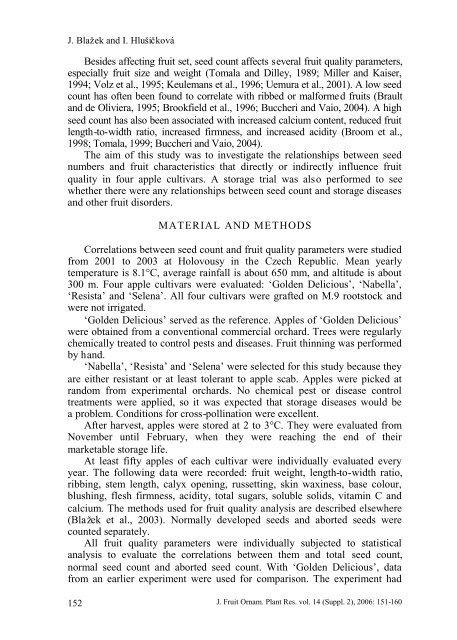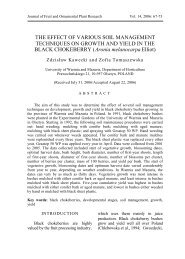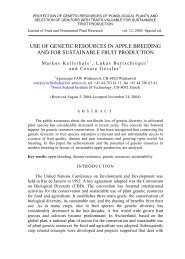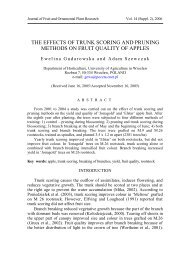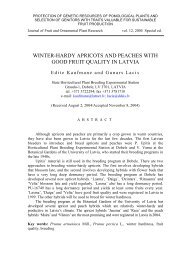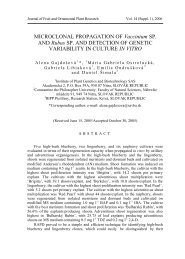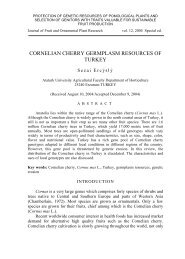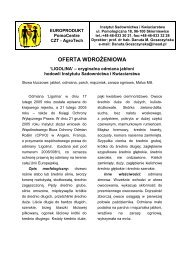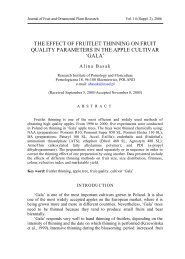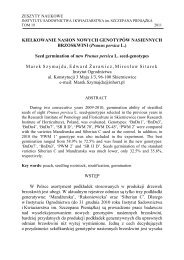seed count, fruit quality and storage properties in four apple cultivars
seed count, fruit quality and storage properties in four apple cultivars
seed count, fruit quality and storage properties in four apple cultivars
Create successful ePaper yourself
Turn your PDF publications into a flip-book with our unique Google optimized e-Paper software.
J. Blažek <strong>and</strong> I. Hlušičková<br />
Besides affect<strong>in</strong>g <strong>fruit</strong> set, <strong>seed</strong> <strong>count</strong> affects several <strong>fruit</strong> <strong>quality</strong> parameters,<br />
especially <strong>fruit</strong> size <strong>and</strong> weight (Tomala <strong>and</strong> Dilley, 1989; Miller <strong>and</strong> Kaiser,<br />
1994; Volz et al., 1995; Keulemans et al., 1996; Uemura et al., 2001). A low <strong>seed</strong><br />
<strong>count</strong> has often been found to correlate with ribbed or malformed <strong>fruit</strong>s (Brault<br />
<strong>and</strong> de Oliviera, 1995; Brookfield et al., 1996; Buccheri <strong>and</strong> Vaio, 2004). A high<br />
<strong>seed</strong> <strong>count</strong> has also been associated with <strong>in</strong>creased calcium content, reduced <strong>fruit</strong><br />
length-to-width ratio, <strong>in</strong>creased firmness, <strong>and</strong> <strong>in</strong>creased acidity (Broom et al.,<br />
1998; Tomala, 1999; Buccheri <strong>and</strong> Vaio, 2004).<br />
The aim of this study was to <strong>in</strong>vestigate the relationships between <strong>seed</strong><br />
numbers <strong>and</strong> <strong>fruit</strong> characteristics that directly or <strong>in</strong>directly <strong>in</strong>fluence <strong>fruit</strong><br />
<strong>quality</strong> <strong>in</strong> <strong>four</strong> <strong>apple</strong> <strong>cultivars</strong>. A <strong>storage</strong> trial was also performed to see<br />
whether there were any relationships between <strong>seed</strong> <strong>count</strong> <strong>and</strong> <strong>storage</strong> diseases<br />
<strong>and</strong> other <strong>fruit</strong> disorders.<br />
MATERIAL AND METHODS<br />
Correlations between <strong>seed</strong> <strong>count</strong> <strong>and</strong> <strong>fruit</strong> <strong>quality</strong> parameters were studied<br />
from 2001 to 2003 at Holovousy <strong>in</strong> the Czech Republic. Mean yearly<br />
temperature is 8.1°C, average ra<strong>in</strong>fall is about 650 mm, <strong>and</strong> altitude is about<br />
300 m. Four <strong>apple</strong> <strong>cultivars</strong> were evaluated: ‘Golden Delicious’, ‘Nabella’,<br />
‘Resista’ <strong>and</strong> ‘Selena’. All <strong>four</strong> <strong>cultivars</strong> were grafted on M.9 rootstock <strong>and</strong><br />
were not irrigated.<br />
‘Golden Delicious’ served as the reference. Apples of ‘Golden Delicious’<br />
were obta<strong>in</strong>ed from a conventional commercial orchard. Trees were regularly<br />
chemically treated to control pests <strong>and</strong> diseases. Fruit th<strong>in</strong>n<strong>in</strong>g was performed<br />
by h<strong>and</strong>.<br />
‘Nabella’, ‘Resista’ <strong>and</strong> ‘Selena’ were selected for this study because they<br />
are either resistant or at least tolerant to <strong>apple</strong> scab. Apples were picked at<br />
r<strong>and</strong>om from experimental orchards. No chemical pest or disease control<br />
treatments were applied, so it was expected that <strong>storage</strong> diseases would be<br />
a problem. Conditions for cross-poll<strong>in</strong>ation were excellent.<br />
After harvest, <strong>apple</strong>s were stored at 2 to 3°C. They were evaluated from<br />
November until February, when they were reach<strong>in</strong>g the end of their<br />
marketable <strong>storage</strong> life.<br />
At least fifty <strong>apple</strong>s of each cultivar were <strong>in</strong>dividually evaluated every<br />
year. The follow<strong>in</strong>g data were recorded: <strong>fruit</strong> weight, length-to-width ratio,<br />
ribb<strong>in</strong>g, stem length, calyx open<strong>in</strong>g, russett<strong>in</strong>g, sk<strong>in</strong> wax<strong>in</strong>ess, base colour,<br />
blush<strong>in</strong>g, flesh firmness, acidity, total sugars, soluble solids, vitam<strong>in</strong> C <strong>and</strong><br />
calcium. The methods used for <strong>fruit</strong> <strong>quality</strong> analysis are described elsewhere<br />
(Blažek et al., 2003). Normally developed <strong>seed</strong>s <strong>and</strong> aborted <strong>seed</strong>s were<br />
<strong>count</strong>ed separately.<br />
All <strong>fruit</strong> <strong>quality</strong> parameters were <strong>in</strong>dividually subjected to statistical<br />
analysis to evaluate the correlations between them <strong>and</strong> total <strong>seed</strong> <strong>count</strong>,<br />
normal <strong>seed</strong> <strong>count</strong> <strong>and</strong> aborted <strong>seed</strong> <strong>count</strong>. With ‘Golden Delicious’, data<br />
from an earlier experiment were used for comparison. The experiment had<br />
152<br />
J. Fruit Ornam. Plant Res. vol. 14 (Suppl. 2), 2006: 151-160


